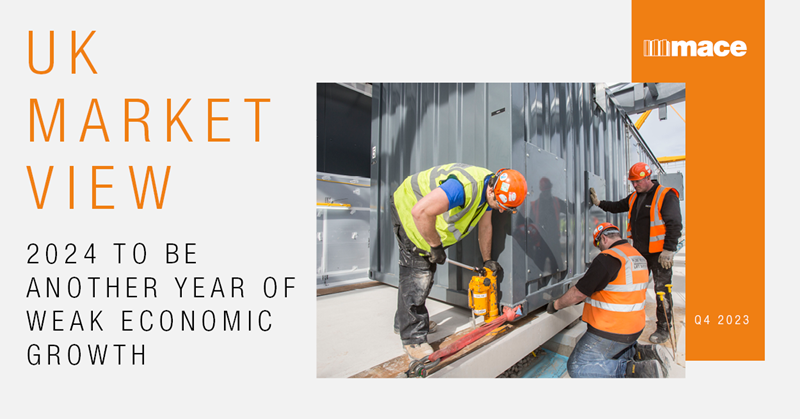2024 to be another year of weak economic growth
The first nine months of 2023 saw construction growing at around twice the rate of the wider economy, with output rising by 1%. Despite the problems in the housing market this is a definite success, but low economic growth looks set to continue into this year, and possibly beyond. GDP growth was low in 2023 and on average forecasters expect it to be even weaker this year.
Our Q4 Market View includes analysis of just how challenging 2023 has been for construction. Although several sectors have seen growth in terms of new work, there is weakness, largely down to problems in the housing sector, with private housing output down 13.4% from Q3 2022. The wider economy is also struggling, with GDP flatlining in Q3 and forecasts for the year ahead weak. Our Global Head of Cost and Commercial Management, Andy Beard, shares his views on the projected impact of broader economic trends and how the industry can attempt to mitigate insolvencies.
Material Impact
A fundamental component of construction’s performance lies in the cost and availability of raw materials and components. Material prices have continued to ease slowly, falling by 1.1% between Q.2 and Q.3 2023. However, a survey from RICS found that 35% of respondents in Q.3 still cited material shortage as a factor limiting activity – significantly lower than 80% in the previous year’s survey – but a worrying indicator of construction faltering at the procurement stage. Managing the supply chain to secure programme and cost must still be treated as a priority by consultants and clients alike.
A Blue (Mon)day for New Orders
The first half of last year was an unequivocal disaster for new construction orders and while they did see a 3.9% rise in Q3, this still leaves them 20% down on this time last year. The increase, from such a low base, can hardly be considered a positive.
On a rolling four-quarterly basis, which avoids some of the volatility that often occurs with the new orders numbers, there was also a significant drop, with new public housing the only sector in a better position than in Q3 2022. Given some of the difficulties facing construction output this year, this set of poor new orders data doesn’t bode well for the next 12 months.
Planning Reform Must Not be a Token Gesture
One common complaint from the construction industry is that planning rules are too cumbersome and decisions can take too long. This can apply to all types of construction project, and the Autumn Statement had several proposals aimed at reducing these blockages. These included cutting the time taken for Nationally Significant Infrastructure Projects to pass through the planning process by increasing the number of planning inspectorates, and a new ‘Star Chamber’ to drive delivery.
Those in construction will be hoping the new ministerial appointment isn’t as toothless government appointment as the housing minister, which has now had sixteen people doing the job since 2010. Real, collaborative frameworks between policymakers and the industry will be needed to sharpen the planning process.
With a general election set to take place, questions around when the Bank of England will cut rates and forecasts from the Office for Budget Responsibility of declining business and government investment in the longer term, the economic landscape for 2024 appears increasingly uncertain.
For deeper insight into the previous quarter and how it could impact future performance, read our full market report.









